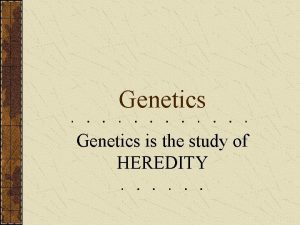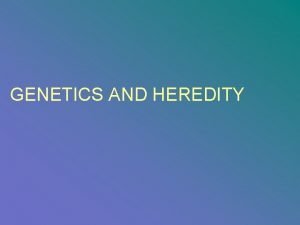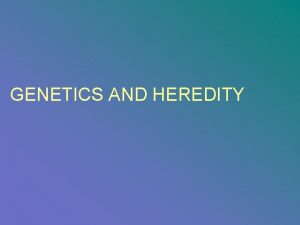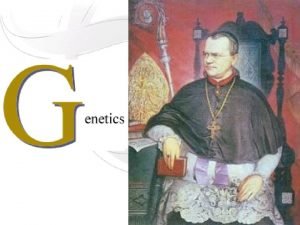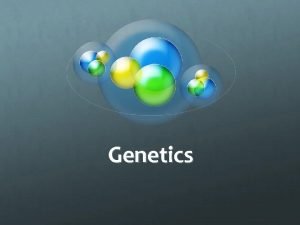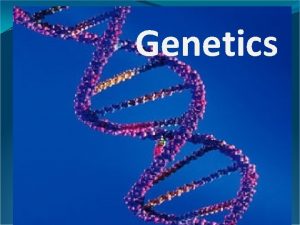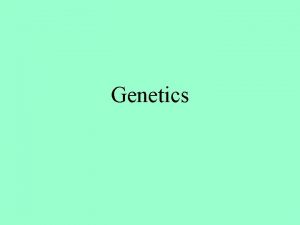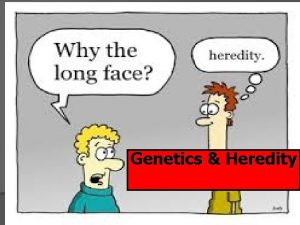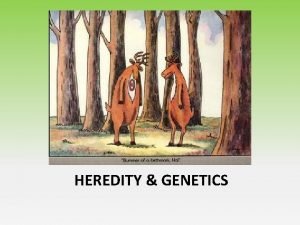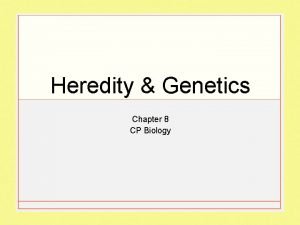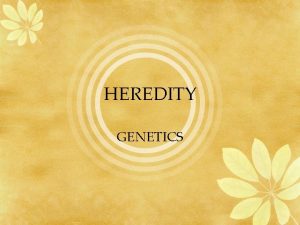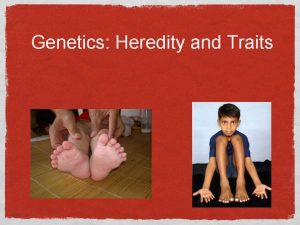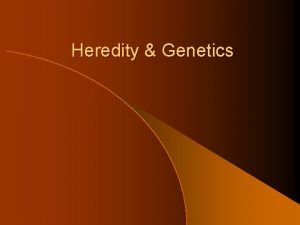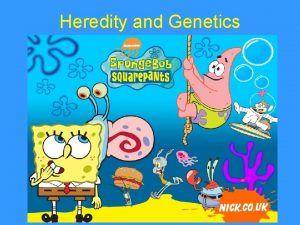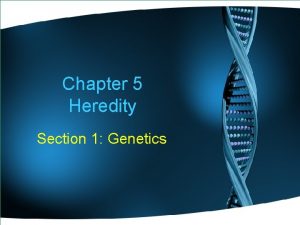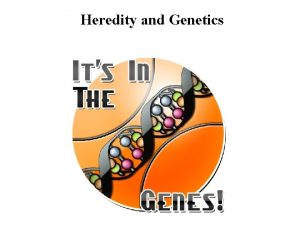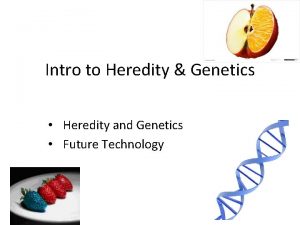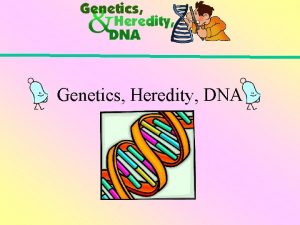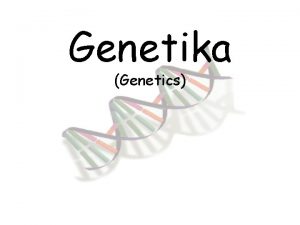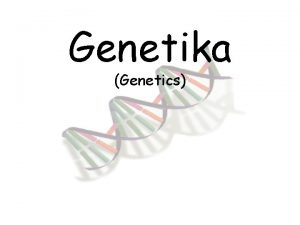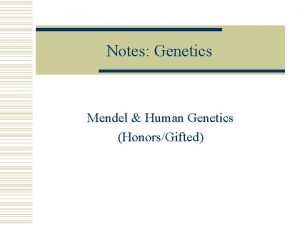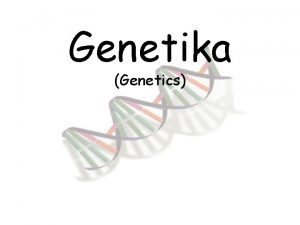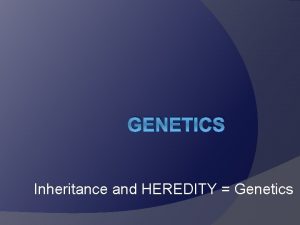What is Genetics The study of Heredity Heredity

































- Slides: 33


What is Genetics? • The study of Heredity • Heredity is the passing of genetic information from one generation to the next

Genes • Each cell nucleus contains DNA (hereditary information) in the form of chromosomes

Genes are located on these chromosomes, and each gene carries a piece of coded information Each cell in your body has over 6 feet of chromosomes tightly coiled inside!



The Human Genome • A genome is all of the genes possessed by an organism • The human genome consists of over 100, 000 genes • Each gene has at least 10, 000 nucleotide pairs


DNA • DNA resembles a twisted ladder called a double helix. • It is made up of subunits called nucleotides. • Each subunit or nucleotide contains 3 chemical parts: • A sugar, a phosphate, and a nitrogenous base (ATCG)

Base Pairs • The four bases found in DNA are Thymine (T) , Adenine (A), Cytosine (C), and Guanine (G) • A always bonds with T and G always bonds with C • Remember: AT Garden City • Bases are joined by weak hydrogen bonds

DNA Base Pairing Animation

Match up the Base Pairs A G C T T G T C A • • • T C G A A C A G T


DNA Replication • When DNA needs to copy itself, the hydrogen bonds between bases “unzip” and the DNA separates into 2 single strands. • Each single strand serves as a template or pattern • Using the base pair rule, 2 new double strands form which are identical to the original double strand



RNA • RNA is similar to DNA except: 1. m. RNA is always single stranded 2. The sugar is ribose instead of deoxyribose 3. RNA contains Uracil (U) instead of Thymine (T) • Therefore, every time m. RNA copies DNA, the A in DNA bonds to a U in m. RNA instead of a T


Protein Synthesis • DNA codes for your protein • Proteins are made by the Ribosomes • Proteins include enzymes, antibodies, hormones, hair, muscle, etc. • The process of protein synthesis involves 2 steps: • Transcription and Translation


1. Transcription • The process of passing genetic information from DNA to RNA • Takes place in the Nucleus • A molecule of DNA “unzips” and one side acts as a template for producing m. RNA • m. RNA (messenger RNA) copies the DNA code and carries it to the ribosomes




2. Translation • Takes place in the Cytoplasm at the Ribosomes and involves m. RNA and t. RNA (transfer RNA) • Every strand of m. RNA now contains the genetic code called CODONS (groups of 3 bases) Ex: AUG

• Every CODON codes for a specific Amino Acid • t. RNA translates codons into amino acids (AA) and carries the AA to the ribosomes • The ribosomes use the Amino Acids to make Proteins!



Review of Terms: 3 Nitrogen Bases CODONS (A, U, C, G (RNA) PROTEINS Amino Acids

Codons • How does RNA know when a protein code is done? • Each codon codes for a specific Amino Acid • There are codons that signal “start” and “stop” • Ex: m. RNA “start” codon is AUG • There are 3 “stop” codons: UAG, UAA, UGA



Central Dogma Transcription Translation DNA RNA PROTEIN A-T A-U Amino G-C Acids
 Genetics is the study of heredity and variation.
Genetics is the study of heredity and variation. Chapter 17 the beginning of the life cycle
Chapter 17 the beginning of the life cycle ____________ is the study of heredity.
____________ is the study of heredity. Mendelian genetics vocab
Mendelian genetics vocab Codominant biology definition
Codominant biology definition Tư thế ngồi viết
Tư thế ngồi viết V cc
V cc Voi kéo gỗ như thế nào
Voi kéo gỗ như thế nào Thẻ vin
Thẻ vin Thể thơ truyền thống
Thể thơ truyền thống Khi nào hổ con có thể sống độc lập
Khi nào hổ con có thể sống độc lập Từ ngữ thể hiện lòng nhân hậu
Từ ngữ thể hiện lòng nhân hậu Thế nào là hệ số cao nhất
Thế nào là hệ số cao nhất Diễn thế sinh thái là
Diễn thế sinh thái là Slidetodoc
Slidetodoc Vẽ hình chiếu vuông góc của vật thể sau
Vẽ hình chiếu vuông góc của vật thể sau Làm thế nào để 102-1=99
Làm thế nào để 102-1=99 Lời thề hippocrates
Lời thề hippocrates Vẽ hình chiếu đứng bằng cạnh của vật thể
Vẽ hình chiếu đứng bằng cạnh của vật thể Chụp tư thế worms-breton
Chụp tư thế worms-breton đại từ thay thế
đại từ thay thế Quá trình desamine hóa có thể tạo ra
Quá trình desamine hóa có thể tạo ra Cong thức tính động năng
Cong thức tính động năng Sự nuôi và dạy con của hổ
Sự nuôi và dạy con của hổ Thế nào là mạng điện lắp đặt kiểu nổi
Thế nào là mạng điện lắp đặt kiểu nổi Các châu lục và đại dương trên thế giới
Các châu lục và đại dương trên thế giới Dot
Dot Nguyên nhân của sự mỏi cơ sinh 8
Nguyên nhân của sự mỏi cơ sinh 8 Bổ thể
Bổ thể Phản ứng thế ankan
Phản ứng thế ankan Thiếu nhi thế giới liên hoan
Thiếu nhi thế giới liên hoan điện thế nghỉ
điện thế nghỉ Chúa yêu trần thế alleluia
Chúa yêu trần thế alleluia Một số thể thơ truyền thống
Một số thể thơ truyền thống


